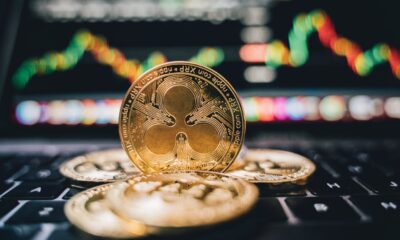Crypto
Uniswap Introduces Its Own Ethereum Layer 2 Network: UniChain as a Game Changer for DeFi
UniChain, Uniswap’s Layer 2 solution for Ethereum, uses Optimistic Rollups to reduce high transaction fees and network congestion by processing transactions off-chain. It aims to enhance speed and lower costs for users, addressing Ethereum’s scalability issues. This move could boost Uniswap’s dominance in DeFi, offering faster, cheaper, and secure transactions, driving mass adoption.

Uniswap, one of the leading decentralized exchanges (DEX) in the Ethereum ecosystem, recently announced the launch of its own Layer 2 network called UniChain. This development could significantly improve the scalability and efficiency of decentralized finance (DeFi) applications and usher in a new era for the platform and the entire Ethereum network.
The move is part of a larger trend in the DeFi space, where Layer 2 solutions are playing a central role in addressing Ethereum’s increasing capacity and cost issues.
What is UniChain?
UniChain is Uniswap’s custom Layer 2 solution for Ethereum, based on Optimistic Rollups technologies. These Layer 2 networks operate in parallel to the Ethereum mainnet and enable faster and cheaper transactions by processing transactions outside of the main blockchain and only sending the results back to the Ethereum main chain. This scaling solution is designed to greatly reduce the high transaction costs and network congestion that have plagued the Ethereum network for years.
Why does Uniswap need its own Layer 2 network?
The rise in Ethereum fees and slower transaction times have caused frustration for users of Uniswap and other DeFi platforms. The Ethereum network that Uniswap is based on has experienced significant capacity constraints during periods of high usage, resulting in high gas fees.
These issues have made access to decentralized financial services increasingly difficult for smaller users. A proprietary Layer 2 network like UniChain aims to solve these problems by reducing transaction costs while increasing the efficiency and speed of the platform.
With UniChain, Uniswap aims to ensure the platform is ready for the next phase of mass adoption. The network will allow users to transact without the high costs of the Ethereum mainnet, while maintaining Ethereum’s security and decentralization.
The technology behind UniChain
UniChain is based on the Layer 2 technology of so-called Optimistic Rollups. Optimistic Rollups are a scaling solution in which transactions are bundled and processed as “batches” to relieve the load on the main blockchain. Transactions are “optimistically” assumed to be correct unless they are questioned by a validator. This approach is more efficient than other Layer 2 solutions because it requires less computing power while still offering a high level of security.
Impact on the DeFi market
The launch of UniChain could have far-reaching effects on the DeFi sector. Uniswap is one of the largest decentralized exchanges with a daily trading volume of several billion US dollars. By introducing its own Layer 2 network, Uniswap could further consolidate its position and expand its dominance in the market. Cheaper and faster transactions could not only retain existing users, but also attract new users who have previously been deterred by the high costs of the Ethereum mainnet.
In addition, UniChain could serve as a blueprint for other DeFi projects that have similar scaling issues. As demand for Ethereum and DeFi applications continues to rise, the need for efficient Layer 2 solutions becomes more and more urgent. Uniswap could take a pioneering role here and pave the way for future developments in the industry.
Conclusion: A step in the right direction
With the launch of UniChain, Uniswap is setting an important milestone for the future of decentralized finance. Solving Ethereum’s scaling issues is crucial to driving mass adoption of DeFi, and Uniswap has taken the first step toward achieving this goal with UniChain.
It remains to be seen how the new technology will perform in practice, but the outlook is promising. Cheaper, faster, and more secure transactions could give Uniswap an even bigger lead and change the DeFi market for good.
__
(Featured image by Zoltan Tasi via Unsplash)
DISCLAIMER: This article was written by a third party contributor and does not reflect the opinion of Born2Invest, its management, staff or its associates. Please review our disclaimer for more information.
This article may include forward-looking statements. These forward-looking statements generally are identified by the words “believe,” “project,” “estimate,” “become,” “plan,” “will,” and similar expressions. These forward-looking statements involve known and unknown risks as well as uncertainties, including those discussed in the following cautionary statements and elsewhere in this article and on this site. Although the Company may believe that its expectations are based on reasonable assumptions, the actual results that the Company may achieve may differ materially from any forward-looking statements, which reflect the opinions of the management of the Company only as of the date hereof. Additionally, please make sure to read these important disclosures.
First published in BLOCK-BUILDERS.DE. A third-party contributor translated and adapted the article from the original. In case of discrepancy, the original will prevail.
Although we made reasonable efforts to provide accurate translations, some parts may be incorrect. Born2Invest assumes no responsibility for errors, omissions or ambiguities in the translations provided on this website. Any person or entity relying on translated content does so at their own risk. Born2Invest is not responsible for losses caused by such reliance on the accuracy or reliability of translated information. If you wish to report an error or inaccuracy in the translation, we encourage you to contact us

-

 Crowdfunding1 week ago
Crowdfunding1 week agoGörlitz Christmas Crowdfunding Campaign Exceeds All Goals
-

 Markets3 days ago
Markets3 days agoMarkets Rise as Global Risks Mount
-

 Business2 weeks ago
Business2 weeks agoThe TopRanked.io Weekly Digest: What’s Hot in Affiliate Marketing [BullionVault Affiliates Review]
-

 Crypto1 week ago
Crypto1 week agoGoldman Sachs Upgrades Coinbase, Citing Strong Growth Outlook

























